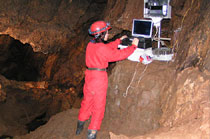 Karst climatology is dealing with the principles of air movement and changes and their influence on karst processes. It studies the physical and chemical processes on the karst surface as well as in caves. The caves represent a special natural environment, which by its morphology and closeness determines the specific microclimatic settings in underground spaces.
Karst climatology is dealing with the principles of air movement and changes and their influence on karst processes. It studies the physical and chemical processes on the karst surface as well as in caves. The caves represent a special natural environment, which by its morphology and closeness determines the specific microclimatic settings in underground spaces.
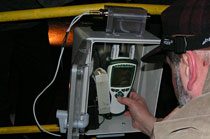 The climatological research on the karst surface in Slovakia is aimed at monitoring of rainfall as the most important factor of karstification in the temperate climatic zone, of changing the seasonal types of weather, of the vegetation cover and regime of evaporation. An emphasis on microclimatological settings studying is placed in the cave environment. The actual monitoring of basic parameters of cave climate is done by several approaches and limited by financial demands of the modern measuring and datalogging devices. We can distinguish the long-term and short-term monitoring.
The climatological research on the karst surface in Slovakia is aimed at monitoring of rainfall as the most important factor of karstification in the temperate climatic zone, of changing the seasonal types of weather, of the vegetation cover and regime of evaporation. An emphasis on microclimatological settings studying is placed in the cave environment. The actual monitoring of basic parameters of cave climate is done by several approaches and limited by financial demands of the modern measuring and datalogging devices. We can distinguish the long-term and short-term monitoring.
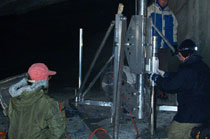
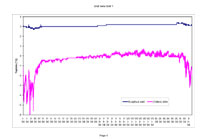 The long-term continuous monitoring is aimed at cognition of the course of dominant components of speleoclimate in separate climatically different parts of caves and cave systems during a long term period (several years). It is realized in caves with exceptionally precious and sensitive aragonite or ice fills, where the global changes in atmosphere as well as anthropogenic factors (change of cave spaces morphology, opening new entrances) can play an important negative role. The research in such caves is broadened by observations of heat transfer between the rock and atmosphere and conduction of heat in the rock or secondary fills (like ice) and their relation with air movement as the medium transporting the thermal energy.
The long-term continuous monitoring is aimed at cognition of the course of dominant components of speleoclimate in separate climatically different parts of caves and cave systems during a long term period (several years). It is realized in caves with exceptionally precious and sensitive aragonite or ice fills, where the global changes in atmosphere as well as anthropogenic factors (change of cave spaces morphology, opening new entrances) can play an important negative role. The research in such caves is broadened by observations of heat transfer between the rock and atmosphere and conduction of heat in the rock or secondary fills (like ice) and their relation with air movement as the medium transporting the thermal energy.
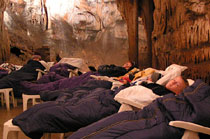 The short-term continuous monitoring is realized usually during one climatic year. It is done in caves where the detail data on microclimate are missing or where another use of cave is presumed (curative, religious, tourist etc.). So called micro-regime observations are realized in show caves within the short-term monitoring. Their aim is the detail cognition of microclimate changes in one second intervals as for the time necessary for its regeneration. Such a knowledge serves us to set the limits of carrying capacity without permanent changes and to regulate the number of visitors in a given time interval.
The short-term continuous monitoring is realized usually during one climatic year. It is done in caves where the detail data on microclimate are missing or where another use of cave is presumed (curative, religious, tourist etc.). So called micro-regime observations are realized in show caves within the short-term monitoring. Their aim is the detail cognition of microclimate changes in one second intervals as for the time necessary for its regeneration. Such a knowledge serves us to set the limits of carrying capacity without permanent changes and to regulate the number of visitors in a given time interval.
Qualitative attributes of cave climate and speleoaerosol are used in selected caves for curative and healing purposes.
The speleoclimatological research and monitoring in Slovak caves is provided by the Slovak Caves Administration in Liptovský Mikuláš. We cooperate with foreing scientific institutes on research in ice caves on the basis of agreement (mainly the Wroclaw University in Poland).
Dear visitors, visiting the cave requires adequate physical fitness.
The route includes:
- a longer walk in an enclosed darkened area
- reduced temperature and increased humidity
- ascent and descent
- higher number of steps (in some caves)
Special note to persons with medical limitations:
If you suffer particularly from cardiovascular disease, respiratory problems, high blood pressure, mobility limitations or are in poor physical condition, please consider taking part in the tour.
If you have any doubts about the appropriateness of your visit, please consult your doctor about your medical condition.
Your safety is of paramount importance to us.
Thank you for your understanding
Slovak Caves Administration, State Nature Conservation of the Slovak Republic
Dear visitors, we would like to inform you that due to the technical conditions of payment terminals, there may be situations when card payment will not be possible. For this reason, we recommend that you have an adequate amount of cash available if you want to be sure that you will be able to visit the cave. Thank you for understanding.
Dear visitors, due to technical reasons at the cave, it is not possible to provide food and drinks, including coffee vending machine services. We apologize for this inconvenience.
Dear visitors, the parking lot doesn't belong to cave administration. The fees are collected by different entity. Thank you for your understanding.